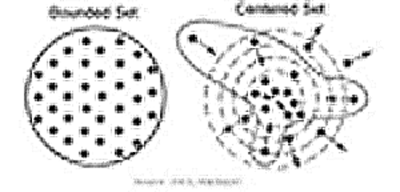From Bounded to Centered
Somewhere around 25 or 30 years ago, anthopologist Paul Hiebert proposed a new way of understanding social groupings. He divided them into centered sets, bounded sets, and fuzzy sets. More recently two books have renewed the discussion on this way of understanding social groups in terms of the way we understand faith communities. Frost and Hirsch use the centered set/bounded set model (“The Shaping of Things to Come”), and Guder et al use the model in their book Missional Church.

Such metaphors can really help here, and Frost and Hirsch use some great ones..
“In the bounded set, it is clear who is in and who is out (fences, not wells), based on a well-defined ideological-cultural boundary –usually moral and cultural codes as well as creedal definitions.. but it doesn’t have much of a core definition beyond these boundaries. It is hard at the edges, soft at the center.”
The centered set, on the other hand, “is like the Outback ranch with the wellspring at its center. It has very strong ideology at the center but no boundaries. It is hard at the center, soft at the edges. We suggest that in the centered set lies a real clue to the structuring of missional communities in the emerging culture.
“The traditional church makes it quite difficult for people to negotiate its maze of cultural, theological, and social barriers in order to get “in.”.. and by the time newcomers have scaled the fences built around the church, they are so socialized as churchgoers that they are not likely to be able to maintain their connection with the social groupings they came from…
“We propose a better and more biblical way.. is to … sink wells. If you sustain your connection with the water sources, you will find a whole host of people relating to Jesus from different walks of life. We allow people to come to Jesus from any direction and from any distance. The Person of Jesus stands.. at the center.” (The Shaping of Things to Come)
Frost and Hirsch propose two metaphors as a way of leading so-called “millennials..” that of herding cats and leading horses to water. Cats are impossible to herd.. they are rugged individualists. But put down a dish of food when they are hungry and they will come to. It is said that you can lead a horse to water but you can’t make it drink.. the authors argue that if you first give the horse salt it will drink. Their conclusion.. cultivate hunger, and provide the right kind of food and people will continue to relate to the center.
![Eds-Cat-Herders[1]](/wp-content/eds-cat-herders%5B1%5D-tm.jpg)